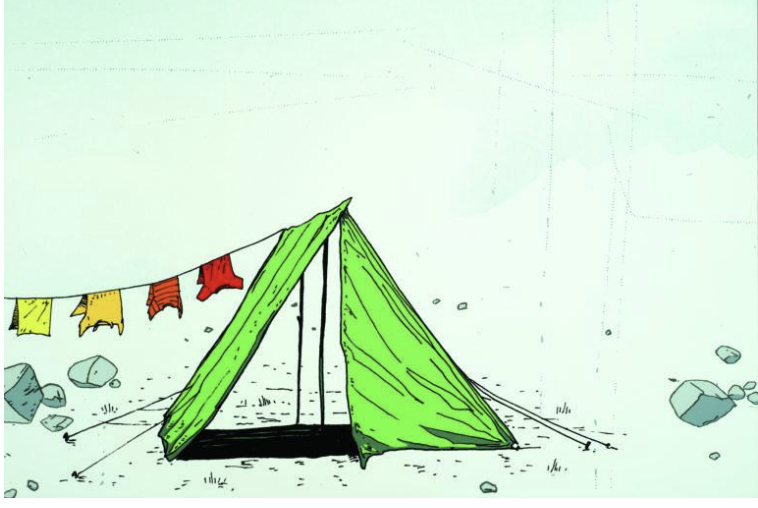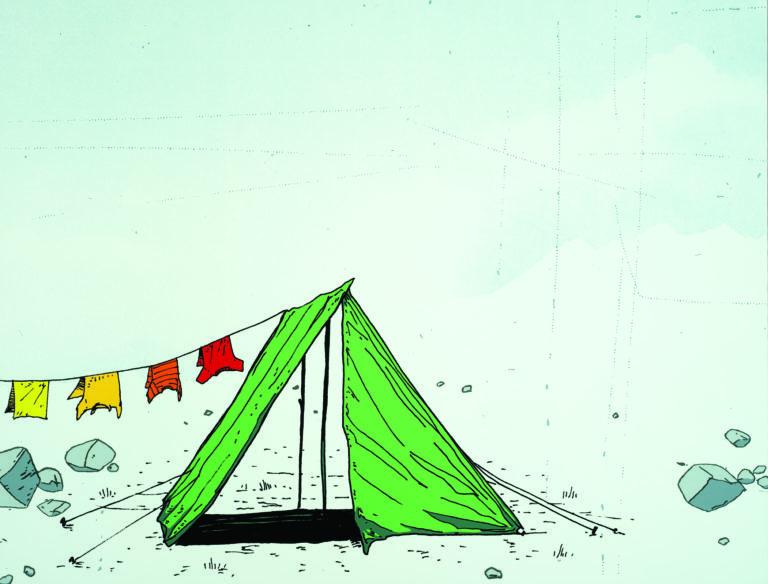The opening-night reception, drawing more people than you’ll encounter at other times in the Academy Art Museum galleries, was no occasion to absorb—much less appreciate—the content of the major new exhibition, Amze Emmons’ “Pattern Drift,” or figure out what the artist is trying to say.
I struggled to glimpse the wall labels, denoting the title of each seemingly inscrutable image amid people balancing canapes and plastic cups of wine. I gave up, knowing I’d return Monday morning to see each of Emmons’ 100-plus pieces in splendid isolation—briefly interrupted by dismissal of a kids’ class upstairs at the museum. Later, Emmons prepared for his three-day artist-in-residence workshop.
The problem with “Pattern Drift” is that there’s way more than meets the eye. Which may not be that unusual in a visual art exhibition—yes, we who appreciate art beyond pretty pictures get that—but Emmons’ architecturally based prints, drawings and cartoon inclinations are almost infuriatingly barren. To view them is to imagine a world left behind, structurally intact but devoid of human life after—what?—a nerve-gas holocaust? (A dog, the only figure I spotted in the show, reminded me of the nuclear-disaster classic “On the Beach.”)
For instance, there are no closing hours at major airports around the globe these days. Yet, if you take in “Pattern Drift” chronologically, clockwise from the first gallery to the left upon entering the museum, you’ll encounter a few takes on “Personal Baggage,” depicting luggage-claim architecture devoid both of landing passengers and arriving suitcases. I found those images sterile. But as I made my way around the “Modern Traveler” iconography of everyday life, from “Urban Lift,” an elevator interior, to “Insinuated Economy,” a plastic-poles and vinyl-ribbon maze to the head of the line, I started to get it.
In the opposite gallery, orange traffic cones and concrete traffic barriers become a recurring theme. “Monument Parade” strings together a non-navigable array of cones strung together by yellow crime-scene tape. But the most currently relevant images are under the rubric of “The Great Machine”: Three abandoned voting stations, devoid of voters, are scattered amid trash and a “VOTE HERE” sign. In “Prisoner’s Dilemma,” two plastic chairs are set before a tangle of concertina wire.
The less-satisfying final galleries at the rear of the museum are highlighted by a cartoonish depiction of an ice chest, like those found outside liquor stores or gas stations, opposite a table of perishables in need of refrigeration, and “Breakfast,” a food truck piled high enough to include a mid rise domicile.
Whether “Pattern Drift,” an architecturally driven show, is satisfying artistically is in the eye of the viewer. But, together with its teasingly enigmatic titles, this singularly focused exhibition attempts, if not altogether succeeds, in eliciting thoughtful engagement. Just take your time to process.
HEATHER HARVEY
Borrowing a Celtic term for her first exhibition in Easton, where she collects discarded material and turns it into art at her studio, Heather Harvey combines scientific curiosity with found
objects to create installations that express her vision of “The Thin Place.” Not that I’ve encountered such a place, but it’s said to be a permeable divide between living and dead, heaven and earth, commonplace and out of this world. Three installations and a dozen watercolors explore this theme through very different means and skill sets. You wouldn’t guess the installations and paintings are by the same artist.
Two poster-sized paintings greet the viewer who takes the stairs to Academy’s second-floor gallery space. But these cheerful abstracts don’t prepare you for the turmoil a few steps ahead. “Up,” a 2019 installation—all works in this show were created this year—suspends large pieces of plastic, metal and wood debris as if caught in a stop-action tornado. Similarly, “All the Tomorrows,” a collage of mostly identifiable objects—measuring tape, ribbons, plastic and cardboard packing material as well as broken eyeglasses and a child’s sandal—appear to be streaming in a ferocious wind temporarily holding its breath. Somewhat more subdued, “Order of Things,” projects pure disorder in its amalgam of crumbling plaster on twisted wire, tinsel from a bygone Christmas tree and a collapsed smiling-sun balloon. Each piece suggests chaos, a maelstrom of that which once was, now ripped asunder.
Harvey’s paintings, by contrast, radiate a geometric sense of order. “Belonging” brings to mind celestial objects clumped together against a field of vectors, while “Joy” evokes orbiting spheres in a bright peach-and-lime universe. “Nothingness Shows Through” begs the question: Is this the Big Bang or is that dark center a black hole? By contrast, “Hobe Sound, 1-17-19 [for Mary Oliver],” is far more personal, denoting the place and time of death of a poet friend of Harvey’s while reflecting both gloom over loss and celebration of a life fully lived.
Will you know, after viewing this show, what a “thin place” is? I can’t say, but it’s a phat place to visit.
JAMES TURRELL

James Turrell, Mapping Spaces 2, 1987, Aquatint, photoetching, soft-ground etching and drypoint in colors, AAM 2018.14
“Mapping Places” is not quite an exhibit. Rather, it’s five new acquisitions added to the Academy Art Museum’s permanent collection showcased in its lobby. For a half century, James Turrell has worked with light and space as he says, “to create an experience of wordless thought, to make the quality and sensation of light itself something really quite tactile.”
These five pieces were created by Turrell in 1987 as a print reference to portions of an unprecedented artwork being created within the volcanic Roden Crater in Arizona’s Painted Desert. Enumerated 1 through 5, each “mapping space” offers the artist’s take on human visual and psychological perception. One evokes an image we’ve all seen: Moonlight, perhaps, reflected on a dark body of water. Another projects a mapping device over what appears to be a wood-grain plain. Or is it a desert seen from the sky? Another is a photo of the Roden Crater itself with what appears to be beacon of light at its core.
All are worthy additions to the Academy’s collection. But none can possibly hold a candle, so to speak, to the actual Roden Crater project, the culmination of a lifetime of work in the field of light as perception. Maybe that could one day be an ambitious Academy-sponsored road trip.
Steve Parks is a retired journalist, arts writer and critic now living in Easton.
AMZE EMMONS: “Pattern Drift”
HEATHER HARVEY: “The Thin Line”
JAMES TURRELL: “Mapping Spaces”
Through Sept. 30, Academy Art Museum, 106 South St., Easton (soon to have new Harrison Street entrance); academyartmuseum.org, 410-822-4787





Write a Letter to the Editor on this Article
We encourage readers to offer their point of view on this article by submitting the following form. Editing is sometimes necessary and is done at the discretion of the editorial staff.